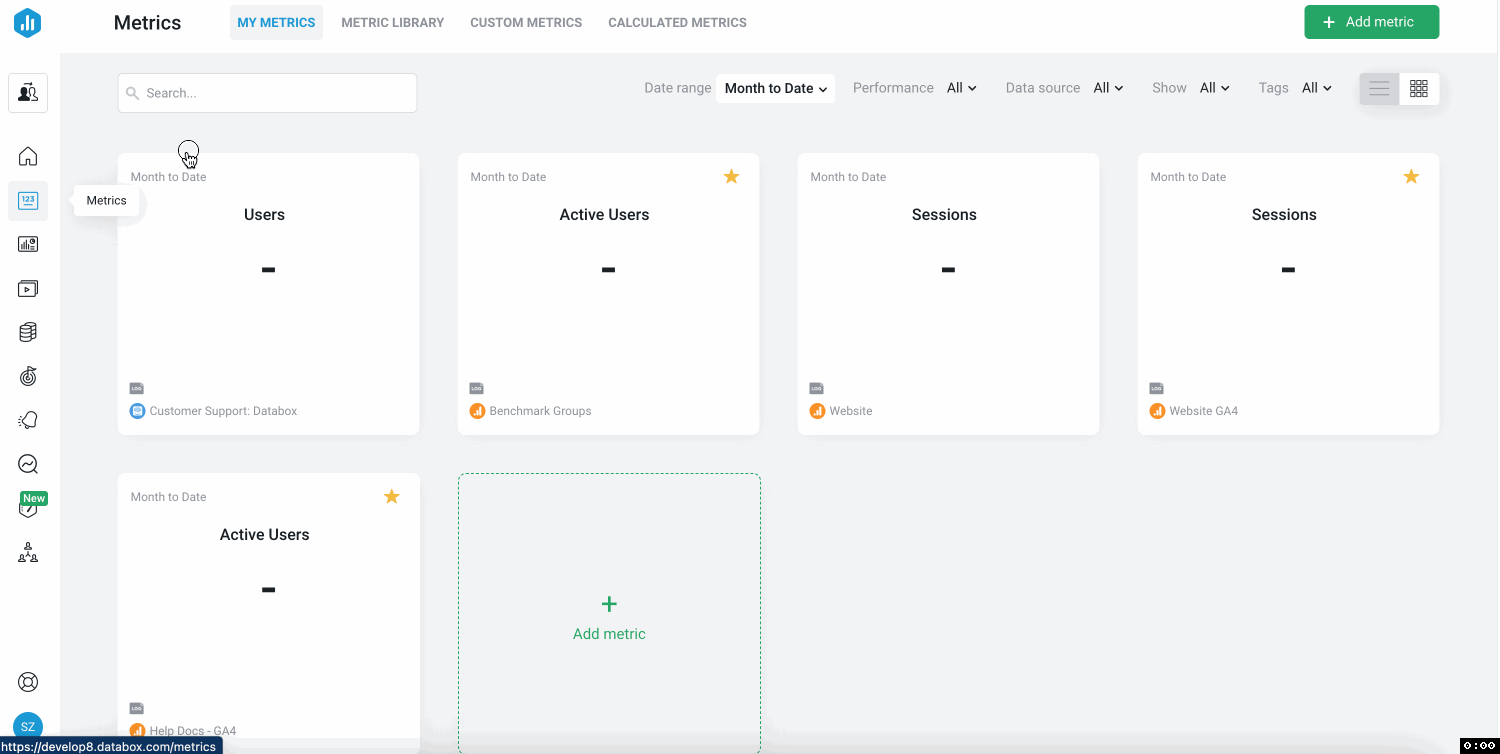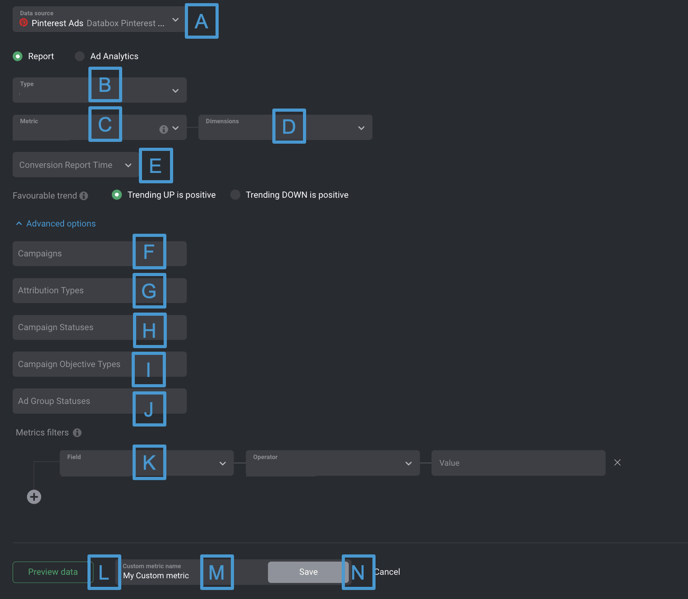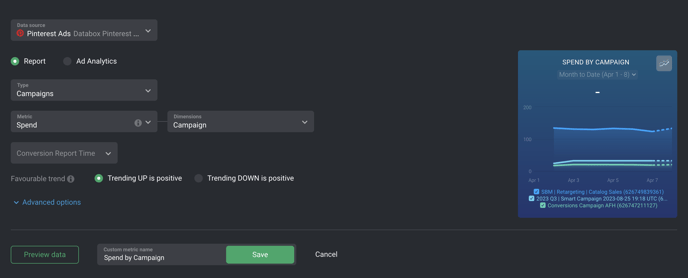Overview: Metric Builder for Pinterest Ads (Report)
- Access the Metric Builder for Pinterest Ads (Report)
- Use the Metric Builder for Pinterest Ads (Report)
- Create a Custom Report Metric [Example]
- Add a Custom Report Metric to a Databoard
- Additional Information
How to access the Metric Builder for Pinterest Ads (Report)

Navigate to Metrics > Custom Metrics to access the Metric Builder. Click the green + New Custom Metric button and select your connected Pinterest Ads Account from the Data Source drop-down list. Select the Report radio button.
Metric Builder is available on Professional and higher plans. Request a trial of Metric Builder by following these steps.
How to use the Metric Builder for Pinterest Ads (Report)

- A) Data Source: This is the Pinterest Ads Data Source that the Custom Metric is syncing data from.
- B) Type: Select the type of Report you want to track, such as Campaign, Ad Account or Ad Group.
- C) Metric: Select a Metric from your connected Pinterest Ads Data Source, such as Ad name, Campaign ID or Ad Group ID.
- D) Dimension: The Dimension parameter re-categorizes the returned Metric value based on common criteria. Examples of Dimensions are Campaign, Ad Group, and Campaign Objective Type. If no Dimension is selected, the Custom Metric will store 1 aggregated Metric value for each Date Range.
Pro Tip: Add the word "by" in between the Metric and Dimension in order to determine an appropriate Custom Metric Name. From the Metric and Dimension examples outlined above, we could create the Custom Metrics "CPM by Ad," "Engagement rate by Ad," or “Spend by Ad”.
-
E) Conversion Report Time (Optional): Select the Conversion Report Time such as Time of Ad Action or Time of Conversion. Anchor your report on either number of conversions or number of ad events during the selected date range. Learn more here.
- F) Campaigns: This field is dependent on the type of Report you select from the Type drop-down. You can filter values of each type of the Report by only selected Ads, Ad Groups or Campaigns.
- G) Attribution Types: Select the attribution type for the conversion report from the drop-down.
- H) Campaign Statuses: Select the Campaign Statuses. This will list the campaign statuses for filtering (it only returns data from campaigns with selected statuses).
- I) Campaign Objective Types: Select the Campaign Objective Types. This lists the campaign objective types for filtering (only returns data from campaigns with selected objective types).
- J) Ad Group Statuses: Select the Ad Group Statuses. This lists the ad group statuses for filtering (only returns data from ad groups with selected statuses).
-
K) Metric Filters - Field (Optional): Filters restrict the data that gets included in the Custom Metric. All data that is returned is tested against the Filter(s). Multiple Filters can be combined using AND boolean logic.If the data synced from the Metric and Dimension fields meet the Filter specifications, the data is retained and included in the Custom Metric value. If the data synced from the Metric and Dimension fields don't meet the Filter specifications, the data is excluded from the Custom Metric value. When you select a filter, the following fields will appear progressively as you select an option for each field:
- Operator: Select The Operator for the filter setup
- Values: Enter a Value for your filter setup.
- L) Preview data: After clicking Preview data, a Data Preview of the Custom Metric will be displayed. Daily Metric values are displayed in this section, along with the total Metric values for the Date Range in bold at the bottom. You can view the Data Preview for different Date Ranges by clicking on the drop-down list at the top of the Data Preview.
- M) Custom Metric Name: Enter a name for your Custom Metric. This Custom Metric name will be available in the Designer after saving.
-
N) Save: Save your Custom Metric.
How to create a Custom Report Metric [Example]
In this example, we'll create a Custom Metric to report on Spend tracked in the Pinterest Ads Account, split up based on Campaigns.

- Navigate to Metrics > Custom Metrics
- Click the green + New Custom Metric button
- Select the appropriate Pinterest Ads Data Source
- Select the Report radio button.
- Select Campaigns from the Type drop-down list.
- Select Spend from the Metric drop-down list
- Next, we'll select Campaign from the Dimension drop-down list so that the Spend values returned are split up based on Campaigns.
- We don't need to further Filter the data, so we will leave the Filter section blank as well.
- In order to accurately explain what this Custom Metric is reporting on, we'll name the Custom Metric "Spend by Campaign"
- Click Preview data to generate a Data Preview of the Custom Metric.
- Once we confirm that these are the results we're looking for, we'll click Save to save the Custom Metric.
How to add a Custom Pinterest Ads Metric to a Databoard
Learn how to add a Custom Metric to a Databoard here.
Additional Information
- The Data Preview is limited to display a maximum of 20 Dimensions per Date Range for Dimensional Metrics. Dimensions will be sorted by descending value, therefore the 20 Dimensions with the highest total values will be displayed in the Data Preview for each Date Range.
- Due to API limitations, Quarterly, Yearly and All time granularities are not supported for non-aggregatable metrics such as "Average Video Play Time", "CPS" and "CTR by Ad Group" etc. This may affect visualization options for Charts in Databox. For more information related to a specific Metric, please contact our Support Team via chat or at help@databox.com.
Learn more about Granularity here.